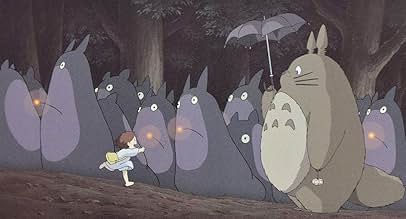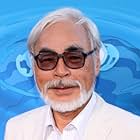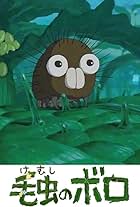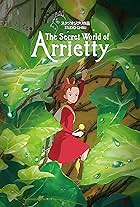IMDb RATING
7.9/10
1.7K
YOUR RATING
A Kittenbus puppy, the cat-shaped bus that is one of the protagonists of My Neighbor Totoro, becomes a great friend of little Mei and with her has an incredible night adventure in the forest... Read allA Kittenbus puppy, the cat-shaped bus that is one of the protagonists of My Neighbor Totoro, becomes a great friend of little Mei and with her has an incredible night adventure in the forest.A Kittenbus puppy, the cat-shaped bus that is one of the protagonists of My Neighbor Totoro, becomes a great friend of little Mei and with her has an incredible night adventure in the forest.
Hayao Miyazaki
- Neko Bâchan
- (voice)
- …
Chika Sakamoto
- Mei
- (voice)
Storyline
Did you know
- TriviaOnly shown at the Ghibli Museum in Tokyo, Japan.
- ConnectionsFollows My Neighbor Totoro (1988)
Featured review
Mei to Koneko basu (Mei and the Kitten Bus, 2002) is an enjoyable animated short with lovable characters, couple of them already known from Tonari no Totoro (My Neighbor Totoro, 1988) feature-length movie, and a number of newly introduced ones. A kind of spin-off of the original movie, this 13-minute short can be seen only in the Studio Ghibli Museum in Mitaka, western suburb of Tokyo. (And what a delightful visit there it was, 20 months ago, almost to the day, in May 2009.) Story revolves around 4-year old Mei Kusakabe (this time without her older sister Setsuki, making here only a brief appearance) who befriends and babysits Koneko basu (Kitten Bus), the offspring of the Neko basu (Cat Bus), often compared to the Cheshire Cat from Lewis Carroll's classic Alice in Wonderland. Spacious hardly enough to accommodate solely little Mei, Koneko basu takes her on a night ride, and flies her in and out of the forest to get her acquainted with the whole fleet of cat-shaped and spirited vehicles, serving their Totoro passengers, to meet sort of a big cat-liner, Neko Bâ-chan (Granny Cat Bus), and revisit the great O-Totoro itself, largest among the spirits "keepers of the forest".
Film offers many favourable ingredients contained in Miyazaki's other, mainly hand-drawn animated adventures: humorous, colourful characters, including child(ren), often girl(s) protagonist(s), character driven animation, subtlety in timing and movements, enchanting visuals with watercolour-like backgrounds, actions involving flying... Lack of subtitles, to otherwise favourable original Japanese soundtrack, for a non-Japanese speaker (Nihon-go wakarimasen!) was not detrimental at all, because it's not about the story told in words, anyway, but about telling it in "thousand times" more descriptive pictures, worming up the feelings, playfulness and imagination omnipresent in children, and, though seemingly forgotten, eventually only suppressed in grown-ups, ergo dormant potential that can be easily activated through the well-administered incentive from the skillful wake-up caller. And who could do it better than a master storyteller, rarely multitalented to simultaneously write, animate (draw), direct and produce at the highest level, whose desire is not exhausted in the process of storytelling, since he prefers to participate and play himself, "suspected" and excused for finding in it as much fun as children do. And, in doing so, he entertains the same desire in us, spectators on the receiving end of his generous and exuberant offer, until, smitten all along, we find the pure joy of it all... ourselves.
Author of, apparently, one of Miyazaki's favourite books for children, Pippi Långstrump (Pippi Longstocking), Sweedish writer Astrid Lindgren used to say: "I don't 'mean' anything by my writing. I just write for the child in myself." It is unlikely that Miyazaki doesn't 'mean' anything by his great and comprehensive anime movie output (Specially in his feature-length movies, his references to contemporary global issues are quite obvious: burning requirement for scaling down the speed of exploitation of natural resources, harmonizing it with the capacity of existing reserves, and allowing for their renewal, improving ecological awareness and reducing pollution, peaceful reconciliation of hostilities ), though it is easily understood that he does the movies for the playful and curious child in himself, as well perhaps--and why not--above all.
Judging by loud ovation from the highest represented, otherwise traditionally self-controlled, if not self-restrained, Japanese children and their parents present at the screening in Ghibli Museum theatre: kids love it and adults enjoy it!
Film offers many favourable ingredients contained in Miyazaki's other, mainly hand-drawn animated adventures: humorous, colourful characters, including child(ren), often girl(s) protagonist(s), character driven animation, subtlety in timing and movements, enchanting visuals with watercolour-like backgrounds, actions involving flying... Lack of subtitles, to otherwise favourable original Japanese soundtrack, for a non-Japanese speaker (Nihon-go wakarimasen!) was not detrimental at all, because it's not about the story told in words, anyway, but about telling it in "thousand times" more descriptive pictures, worming up the feelings, playfulness and imagination omnipresent in children, and, though seemingly forgotten, eventually only suppressed in grown-ups, ergo dormant potential that can be easily activated through the well-administered incentive from the skillful wake-up caller. And who could do it better than a master storyteller, rarely multitalented to simultaneously write, animate (draw), direct and produce at the highest level, whose desire is not exhausted in the process of storytelling, since he prefers to participate and play himself, "suspected" and excused for finding in it as much fun as children do. And, in doing so, he entertains the same desire in us, spectators on the receiving end of his generous and exuberant offer, until, smitten all along, we find the pure joy of it all... ourselves.
Author of, apparently, one of Miyazaki's favourite books for children, Pippi Långstrump (Pippi Longstocking), Sweedish writer Astrid Lindgren used to say: "I don't 'mean' anything by my writing. I just write for the child in myself." It is unlikely that Miyazaki doesn't 'mean' anything by his great and comprehensive anime movie output (Specially in his feature-length movies, his references to contemporary global issues are quite obvious: burning requirement for scaling down the speed of exploitation of natural resources, harmonizing it with the capacity of existing reserves, and allowing for their renewal, improving ecological awareness and reducing pollution, peaceful reconciliation of hostilities ), though it is easily understood that he does the movies for the playful and curious child in himself, as well perhaps--and why not--above all.
Judging by loud ovation from the highest represented, otherwise traditionally self-controlled, if not self-restrained, Japanese children and their parents present at the screening in Ghibli Museum theatre: kids love it and adults enjoy it!
- Davor_Blazevic_1959
- Jan 2, 2011
- Permalink
Details
- Release date
- Country of origin
- Language
- Also known as
- Мей і Кіт - автобус
- Production company
- See more company credits at IMDbPro
Contribute to this page
Suggest an edit or add missing content





















